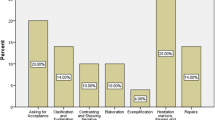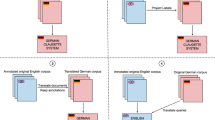Abstract
In this paper, we claim that the disambiguation ofreferring expressions in discourse can be formulated in terms automatedreasoners can address. Specifically, we show that consistency,informativity and minimality are criteria which (i) can be implementedusing automated reasoning tools and (ii) can be used to disambiguatenoun-noun compounds, metonymy and definite descriptions.
Similar content being viewed by others
References
Allen, J. and Perrault, C.R., 1982, “Analyzing intention in utterances,” Artificial Intelligence 15, 143-178. Reprinted as pp. 441-458 in Readings in Natural Language Processing, B. Grosz et al., eds., Los Altos, CA: Morgan Kaufmann Publishers, 1986.
Appelt, D., 1985, Planning English Sentences, Cambridge: Cambridge University Press.
Asher, N. and Lascarides, A., 1998, “Bridging,” Journal of Semantics 15, 83-113.
Baumgartner, P. and Kuhn, M., 1999, “Abducing coreference by model construction,” pp. 21-39 in Proceedings of Inference in Computational Semantics, Amsterdam, C. Monz and M. de Rijke, eds.
Blackburn, P. and Bos, J., 1999, Representation and Inference in Natural Language: A First Course in Computational Semantics, Volume II: Working with Discourse Representations, latest draft available at http://www.comsem.org Blackburn, P., Bos, J., Kohlhase, M., and de Nivelle, H., 1999, “Inference and computational semantics,” pp. 5-21 in Third International Workshop on Computational Semantics (IWCS-3), Tilburg, The Netherlands, H.C. Bunt, I. van der Sluis, E.G.C. Thijsse, eds.
Bry, F. and Torge, S., 1996, “Minimal model generation with positive unit hyperresolution tableaux,” pp. 143-159 in Proceedings TABLEAUX'96, P. Miglioli, U. Moscato, D. Mundici, and M. Ornaghi, eds.
Charniak, E., 1972, “Towards a model of children's story comprehension,” Ph.D. Thesis, Artificial Intelligence Laboratory, Massachusetts Institute of Technology.
Charniak, E., 1973, “Jack and Janet in search of a theory of knowledge,” pp. 337-343 in Proceedings of International Joint Conference on Artificial Intelligence (IJCAI), Los Altos, CA: William Kaufmann.
Chu-Carroll, J. and Carberry, S., 1994, “A plan-based model for response generation in collaborative task-oriented dialogues,” pp. 59-63 in Proceedings of the Third National Conference on Artificial Intelligence (AAAI-94), Washington, DC: AAAI.
Clark, H. and Marshall, C., 1981, “Definite reference and mutual knowledge,” pp. 10-63 in Elements of Discourse Understanding, A. Joshi, B. Webber, and I. Sag, eds., Cambridge: Cambridge University Press.
Crain, S. and Steedman, M., 1985, “On not being led up the garden path: The use of context by the psychological parser,” pp. 320-358 in Natural Language Parsing, L. Kartunnen, D. Dowty, and A. Zwicky, eds., Cambridge: Cambridge University Press.
Finin, T., 1980, “The semantic interpretation of compound nominals,” Ph.D. Thesis, Coordinated Science Laboratory, University of Illinois.
Gardent, C. and Konrad, K., 2000a, “Interpreting definites using model generation,” Journal of Language and Computation, to appear.
Gardent, C. and Konrad, K., 2000b, “Understanding “each other”,” Journal of Language and Computation, to appear.
Gardent, C. and Striegnitz, K., 2001, “Generating indirect anaphora,” pp. 138-155 in Fourth International Workshop on Computational Semantics (IWCS-4), Tilburg, The Netherlands, H. Bunt, I. van der Sluis and E. Thijsse, eds.
Grice, H., 1975, “Logic and conversation,” pp. 41-58 in Syntax and Semantics, Vol. 3, P. Cole and J. Morgan, eds., New York: Academic Press.
Hahn, U. and Markert, K., 1999, “On the formal distinction between literal and figurative language,” pp. 133-147 in Proceedings of the 5th Portugese Conference on Artificial Intelligence, Evora, Portugal, P. Barahona et al., eds., Springer Lecture Notes Series, Vol. 541, Berlin: Springer-Verlag.
Hewitt, C., 1969, “Planner: A language for proving theorems in robot,” pp. 295-301 in Proceedings of International Joint Conference on Artificial Intelligence (IJCAI), Washington, DC.
Hinrichs, E., 1986, “Temporal anaphora in discourses of English,” Linguistics & Philosophy 9, 63-82.
Hintikka, J., 1988, “Model minimization-An alternative to circumscription,” Journal of Automated Reasoning 4, 1-13.
Hobbs, J., Stickel, M., Appelt, D., and Martin, P., 1993, “Interpretation as abduction,” Artificial Intelligence 63, 69-142.
Johnson-Laird, P., 1983, Mental Models: Towards a Cognitive Science of Language, Inference and Consciousness, Cambridge: Cambridge University Press.
Kamp, H., 1979, “Events, instant and temporal reference,” pp. 376-417 in Semantics from Different Points of View, U.E.R. Bauerel and A. von Stechow, eds., Berlin: Springer-Verlag.
Lambert, L. and Carberry, S., 1999, “A process model for recognizing communicative acts and modeling negotiation subdialogues,” Computational Linguistics 25, 1-53.
Lascarides, A. and Asher, N., 1993, “Temporal interpretation, discourse relations and common sense entailments,” Linguistics & Philosophy 16, 437-493.
Lascarides, A. and Copestake, A., 1998, “Pragmatics and word meaning,” Journal of Linguistics 34, 387-414.
Lehnert, W., 1986, “A conceptual theory of question answering,” pp. 651-658 in Readings in Natural Language Processing, B. Grosz, K. Sparck Jones, and B. Webber, eds., Los Altos, CA: Morgan Kaufmann Publishers. First printed as pp. 158-164 in Proceedings of 5th International Joint Conference on Artificial Intelligence, 1977.
Levi, J., 1979, The Syntax and Semantics of Complex Nominals, New York: Academic Press.
Lewis, D., 1979, “Scorekeeping in a language game,” Journal of Philosophical Logic 8, 339-359.
Litman, D. and Allen, J., 1990, “Discourse processing and commonsense plans,” pp. 365-388 in P. Cohen, J. Morgan, and M. Pollack (eds.): Intentions in Communication, Cambridge, MA: MIT Press.
Lorenz, S., 1994, “A tableau prover for domain minimization,” Journal of Automated Reasoning 13, 375-390.
Markert, K. and Hahn, U., 1997, “On the interaction of metonymies and anaphora,” pp. 1010-1015 in Proceedings of International Joint Conference on Artificial Intelligence (IJLAI), Nagoya, Japan, San Francisco, CA: Morgan Kaufmann.
McCarthy, J., 1980, “Circumscription-A form of non-monotonic reasoning,” Artificial Intelligence 13, 27-39.
Moens, M. and Steedman, M., 1988, “Temporal ontology and temporal reference,” Computational Linguistics 14, 3-14.
Monz, C., 1999, “Contextual inference in computational semantics,” pp. 242-255 in Proceedings of the AAAI-99 Workshop on Reasoning in Context for AI Applications, P. Bouquet, P. Brezillon, L. Serafini, M. Benerecetti, and F. Castellan, eds., Washington, DC: AAAI.
Ramsay, A. and Seville, H., 1999, “Models and discourse models,” pp. 111-125 in Proceedings of Inference in Computational Semantics, Amsterdam, C. Monz and M. de Rijke, eds.
Russell, S. and Norvig, P., 1995, Artificial Intelligence: A Modern Approach, Englewood Cliffs, NJ: Prentice Hall.
Sacerdoti, E., 1977, A Structure for Plans and Behavior, Amsterdam: Elsevier/North-Holland.
Schutz, H., 1999, “Generating minimal Herbrand models step by step,” pp. 171-185 in Proceedings TABLEAUX'99, N. Murray, ed., Springer Lecture Notes Series, Vol. 1617, Berlin: Springer-Verlag
Stolcke, A., Ries, K., Coccaro, N., Shriberg, E., Bates, R., Jurafsky, D., Taylor, P., Martin, R., Ess-Dykema, C.V., and Meteer, M., 2000, “Dialog act modeling for automatic tagging and recognition of conversational speech,” Computational Linguistics 26, 339-374.
Stone, M., 1998, “Modality in dialogue: Planning, pragmatics and computation,” Ph.D. Thesis, Department of Computer & Information Science, University of Pennsylvania.
Stone, M., 2000, “Towards a coinputational account of knowledge, action and inference in instructions,” Journal of Language and Computation 1, 231-246.
Stone, M. and Doran, C., 1997, “Sentence planning as description using tree adjoining grammar,” pp. 198-205 in Proceedings of the 35th Annual Meeting of the Association for Computational Linguistics (ACL97/EACL97), Madrid, Spain, San Francisco, CA: Morgan Kaufmann
Stone, M. and Webber, B., 1998, “Textual economy through closely coupled syntax and semantics,” pp. 178-187 in Proceedings of the Ninth International Workshop on Natural Language Generation, Niagara-on-the-Lake, Canada.
Stone, M., Doran, C., Webber, B., Bleam, T., and Palmer, M., 2001, “Microplanning from communicative intentions: Sentence planning using descriptions (SPUD),” Computational Linguistics, submitted.
Strawson, P., 1950, “On referring,” Mind 59, 320-344.
van der Sandt, R., 1992, “Presupposition projection as anaphora resolution,” Journal of Semantics 9, 333-377.
Wilks, Y., 1986, “An intelligent analyzer and understander of English,” pp. 193-204 in Readings in Natural Language Processing, B. Grosz, K. Sparck Jones, and B. Webber, eds., Los Altos, CA: Morgan Kaufmann Publishers. First printed in Communications of the ACM 18(5), 1975, 264-274.
Winograd, T., 1973, “A procedural model of language understanding,” pp. 152-186 in Computer Models of Thought and Language, R. Schank and K. Colby, eds., New York: W.H. Freeman. Reprinted as pp. 249-266 in Readings in Natural Language Processing, B. Grosz et al., eds., Los Altos, CA: Morgan Kaufmann Publishers, 1986.
Author information
Authors and Affiliations
Rights and permissions
About this article
Cite this article
Gardent, C., Webber, B. Towards the Use of Automated Reasoning in Discourse Disambiguation. Journal of Logic, Language and Information 10, 487–509 (2001). https://doi.org/10.1023/A:1017916706972
Issue Date:
DOI: https://doi.org/10.1023/A:1017916706972




